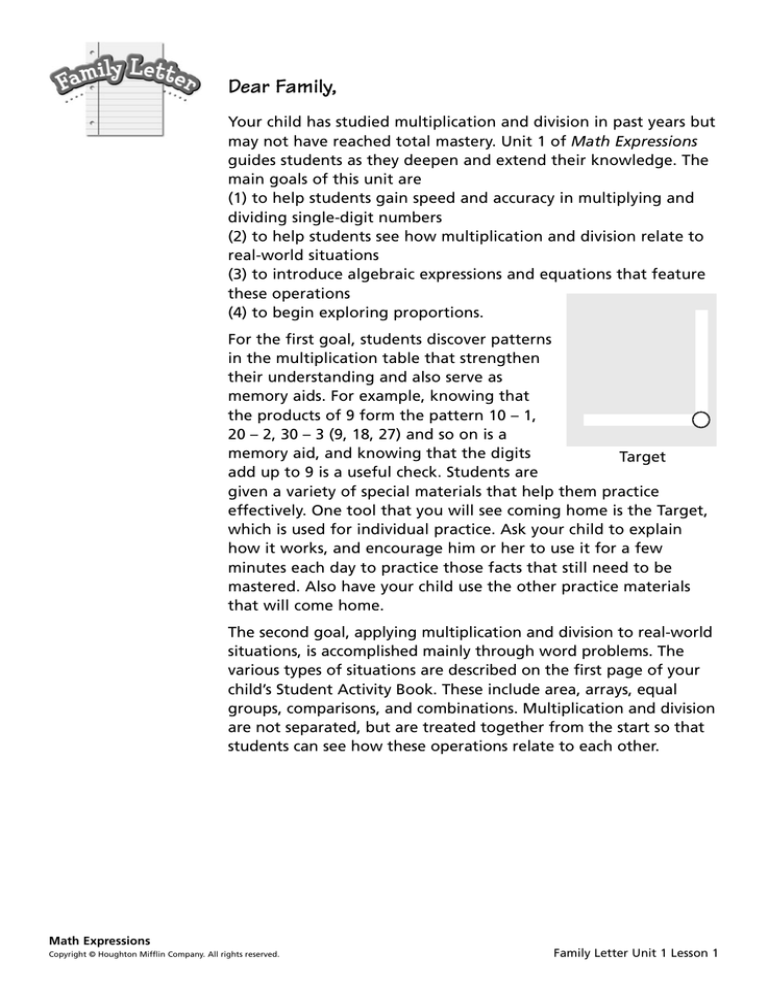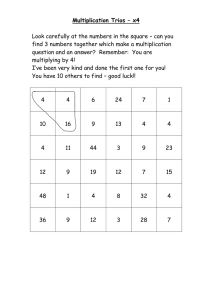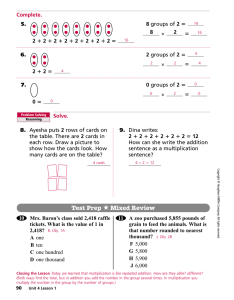
Dear Family,
Your child has studied multiplication and division in past years but
may not have reached total mastery. Unit 1 of Math Expressions
guides students as they deepen and extend their knowledge. The
main goals of this unit are
(1) to help students gain speed and accuracy in multiplying and
dividing single-digit numbers
(2) to help students see how multiplication and division relate to
real-world situations
(3) to introduce algebraic expressions and equations that feature
these operations
(4) to begin exploring proportions.
For the first goal, students discover patterns
in the multiplication table that strengthen
their understanding and also serve as
memory aids. For example, knowing that
the products of 9 form the pattern 10 – 1,
20 – 2, 30 – 3 (9, 18, 27) and so on is a
memory aid, and knowing that the digits
Target
add up to 9 is a useful check. Students are
given a variety of special materials that help them practice
effectively. One tool that you will see coming home is the Target,
which is used for individual practice. Ask your child to explain
how it works, and encourage him or her to use it for a few
minutes each day to practice those facts that still need to be
mastered. Also have your child use the other practice materials
that will come home.
The second goal, applying multiplication and division to real-world
situations, is accomplished mainly through word problems. The
various types of situations are described on the first page of your
child’s Student Activity Book. These include area, arrays, equal
groups, comparisons, and combinations. Multiplication and division
are not separated, but are treated together from the start so that
students can see how these operations relate to each other.
Math Expressions
Copyright © Houghton Mifflin Company. All rights reserved.
Family Letter Unit 1 Lesson 1
Some real-world situations are a little too complex to be solved
without algebra. The third goal, using simple algebraic methods,
is shown by a problem such as this:
A truck carried 6 chairs and a table weighing 40 pounds.
Altogether the chairs and table weigh 100 pounds. How much
does each chair weigh?
Equation:
6 • c ⴙ 40 ⴝ 100
Factor Puzzles are introduced as a way to practice multiplications
and divisions. A Factor Puzzle shows 3 of the 4 numbers found
when 2 rows and 2 columns of the multiplication table intersect
(see below). Students write outside the Factor Puzzle the rows
and columns of the multiplication table, and so can find the
unknown fourth number.
4
9
12 27
3 12 27 3
28
7 28 63 7
4
9
Students enjoy solving Factor Puzzles, and they can also create
them. The Factor Puzzles show number pairs in proportional
relationships. Students will work with these relationships again
when they do equivalent fractions, ratios, and similarity
geometry.
If you have any questions or comments, please contact me.
Sincerely,
Your child’s teacher
Math Expressions
Copyright © Houghton Mifflin Company. All rights reserved.
Family Letter Unit 1 Lesson 1




